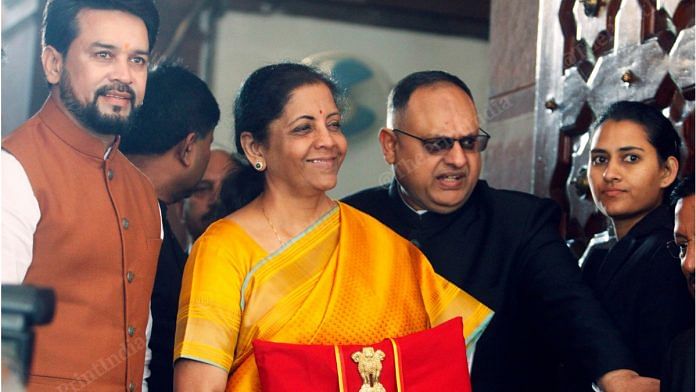New Delhi: Finance Minister Nirmala Sitharaman is set to present her third and perhaps the most challenging budget Monday as she looks to revive an economy severely hit by the pandemic.
The Union Budget 2021-22 will kick off at around 11 am with the FM delivering her budget speech in the Parliament. The rest of the budget documents will be uploaded on the official website after the speech is made.
What’s part of the budget speech?
Traditionally, the budget speech consists of two parts. In Part A, the FM presents an assessment of the economy, makes announcements related to different sectors sometimes accompanied by allocations, and lists out various reforms the government plans to undertake in the coming fiscal.
This year, the budget speech is also likely to devote time to recap the government’s handling of the pandemic and the subsequent Atmanirbhar package that was announced to counter the economic effects of the pandemic.
The Part B of the speech deals with specific changes to the direct tax and indirect tax provisions that are proposed in the budget, including any changes to income tax slabs, exemption limits, savings under Section 80 (C) as well as any deductions allowed to encourage housing purchases.
Any likely changes to capital gains tax are also tackled in this part of the budget speech. Major changes to the indirect tax as well as the rationale are also part of this section. These mainly consist of changes to custom duties of imported goods and excise duties on items like petrol and diesel.
The changes to the goods and services tax (GST) rates are decided outside the budget by the GST council — a federal body comprising the Union finance minister and state finance ministers.
The budget speech also has different annexures — a list that has been increasing with every passing budget.
The annexures typically detail the allocations to important ministries, the details of the subsidies given as well explanations for the changes in custom duties of products.
Last year, in an effort to increase fiscal transparency, the government also detailed its off-budget spending — spending that is undertaken by the government but does not reflect in its fiscal deficit calculations and is typically accounted for by extra budgetary resources and borrowings from the National Small Savings Fund.
Also read: Big health push & some tax relief — what you can expect in Modi govt’s Budget 2021
The fine print
While the budget speech contains the broad overview of the government’s plans and thrust areas for the next fiscal, the rest of the budget documents provide clarity on the fine print of the numbers.
These documents provide detailed numbers for three years.
For instance, the budget documents for 2021-22 will provide the actual numbers for 2019-20, the revised numbers for 2020-21 (the initial budget numbers presented at the beginning of the year are changed towards the end of the fiscal to reflect ground realities), and the budget estimates for 2021-22.
Titled Budget at a Glance, the document provides an overview of government finances with details of the receipts, the expenditure and the fiscal deficit. It also provides a brief overview of tax and non-tax revenues as well as the expenditure allocations to important ministries on account of spending on subsidy and interest payments.
It also lays down the government’s assumptions of nominal GDP growth for the next year. This forms the basis of calculation of ratios like fiscal deficit as percentage of GDP and the basis of estimated revenue collections growth.
Nominal GDP growth has been estimated at around 11 per cent in the last few budgets. However, it came down to just over 7 per cent in 2019-20 and will be negative in 2020-21.
The receipts budget provides a detailed break up of tax collections on account of personal income tax, corporate income tax, GST, customs duties and excise collections. It also provides details of non-tax collections on account of dividends and sale of spectrum. Besides this, it also provides details of the borrowings from the market that are classified as debt receipts as well as receipts on account of divestment.
The expenditure budget provides in detail the allocations to different ministries, classified as revenue and capital expenditure, to distinguish between expenditure allocated for meeting expenses and for creation of capital assets.
Also read: This is when big economies are expected to go back to pre-Covid levels
Finance bill
The other budget documents include the memorandum that explains the rationale and the impact of the proposed direct and indirect tax changes in the budget and the macroeconomic framework statement detailing the direction of important indicators.
The document titled Finance bill contains the details of the proposed amendments to various laws.
Typically, the finance bill is used to only amend the various Acts governing taxes such as the Income Tax Act, the black money Act and the benami provisions Act.
However, governments in the past have used the finance bill to bring in changes to the Reserve Bank of India Act and to the Act governing capital markets regulator Securities Exchange Board of India.
With the government set to miss the fiscal deficit targets for the next couple of years due to the sharp fall in revenues on account of the pandemic, another document that will be keenly watched in the current budget will be the medium-term fiscal policy cum fiscal policy strategy statement.
This statement lays down the trajectory of the fiscal deficit over the next three years and explains the reasons for failing to achieve the previously set targets.
Also read: IMF projects 11.5% growth rate for India in 2021, only country with double digit growth



